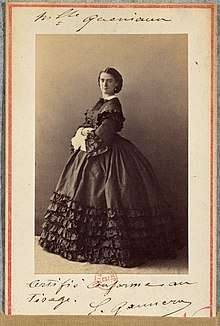Constance Quéniaux
Constance Quéniaux (9 July 1832 – 7 April 1908) was a dancer at the Paris Opera Ballet and the likely model for Gustave Courbet's painting L'Origine du monde.

Life and career
Constance Quéniaux was born to Marie Catherine Quéniaux in Saint-Quentin on 9 July 1832.[1] Her mother was unmarried and she grew up in poverty. She joined the ballet corps of the Paris Opera in 1847, performing minor roles in its repertoire.[2] She rose to secondary soloist position along with Claudina Couqui, receiving acclaim.[3]
She combined her dance career with prostitution. By the age of 34, she had retired from the Opera and was eyeing the favour of an Ottoman diplomat, Halil Şerif Pasha.[4]
Quéniaux was a model for several works, including the Portrait de Mademoiselle Constance Quéniaux, de l'Académie Impériale de Musique (1867), by Jules-Émile Saintin,[5]
Quéniaux in later life was well-off, owning a villa in Cabourg.[6] She became a philanthropist, actively supporting, for instance, the Orphelinat des Arts, an institution for orphaned or abandoned children of artists.[7]
She died in Paris on 7 April 1908. In her will, she left a Courbet painting of camellias. This flower, since the publication of Alexandre Dumas fils' La Dame aux Camélias had been associated with courtesans.[4][8]
L'Origine du monde
Halil Şerif Pasha was a notable collector of arts. He commissioned Gustave Courbet to paint Quéniaux, whom he called his "lucky charm".[7] The work L'Origine du monde hides the model's face. While her identity was known at the time, as Quéniaux grew respectable, the information was lost. Indeed, experts long identified the model with Joanna Hiffernan, an Irish model who was Courbet's lover.[4]
Correspondence between Alexandre Dumas and George Sand was discovered in 2018 by a French historian, Claude Schopp, referring to this painting. It mentions “One does not paint the most delicate and the most sonorous interior of Miss Queniault (sic) of the Opera.” This combined with Quéniaux's bequest of Courbet's painting of camellias (associated with courtesans) strongly suggests that Constance Quéniaux was Courbet's model.[4]
Further reading
- Claude Schopp (2018). L’Origine du Monde : Vie du Modèle. Paris: Phébus. ISBN 978-2-7529-1178-0.
References
| Wikimedia Commons has media related to Constance Quéniaux. |
- "Constance L'origine du monde". Geneanet. Retrieved 27 September 2018.
- Théophile Gautier; Ivor Guest (1995). Ecrits sur la danse. Actes Sud. p. 254. ISBN 978-2-7427-0232-9.
- Edwin Binney (1965). Les Ballets de Théophile Gautier. Libr. Nizet. p. 296.
- "Mystery solved? Identity of Courbet's 19th-century nude revealed". The Guardian. Agence France-Presse. 25 September 2018. Retrieved 27 September 2018.
- Explication des ouvrages de peinture, sculpture, architecture, gravure, dessins, modeles. Veuve Hérissany. 1867. p. 283.
- Bénédicte Robin; Nathalie Lopes; Eric Chaverou (25 September 2018). "Mademoiselle Constance Quéniaux, la femme à "L'Origine du monde"". France Culture. Retrieved 27 September 2018.
- Ludivine Trichot (26 September 2018). "Le fabuleux destin de Constance Quéniaux, la femme représentée dans L'Origine du monde". Le Figaro. Retrieved 27 September 2018.
- Adam Sage (26 September 2018). "Riddle of Gustave Courbet's nude in L'Origine du Monde finally solved". The Times. Retrieved 27 September 2018.